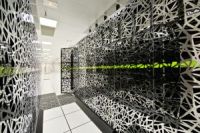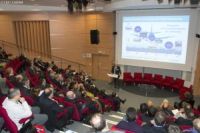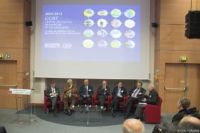 |
|||||
|
 |
 |
 |
Home > News > Members and Partners News > CEA
| December 4, 2015 -
The first phase of TERA 1000, the new pre-exascale supercomputer, has been delivered and installed by Atos at CEA/DAM (the CEA’s military applications Division). Completion of this first phase makes it possible to reduce energy consumption by a factor of five, compared to the previous supercomputer TERA 100 (1), while doubling its peak compute performance. The compute needs of the CEA’s programs require the implementation of an exascale-class (2) supercomputer by 2020. To deliver a system of this size calls for technological breakthroughs. First, to control the electricity consumption of such a system. Secondly, to regulate the data throughputs and to master the huge quantity of data produced by simulations which are ever more precise, in order to model multi-physical and multidimensional phenomena. To achieve this objective, CEA decided to apply from a very early stage a co-design methodology with Atos, in collaboration with Intel. The aim is to maximize performance by testing interactions between applications and the supercomputer. The CEA’s expertise covers several areas: from the code structure of applications through to code interaction with the supercomputer and up to the architecture of the supercomputer. The second phase of TERA 1000, which will be up and running by 2017, will consist of 30 Bull sequana X1000 cells, integrating more than 8000 Intel® Xeon Phi™ Knights Landing processors connected by the very high performance BXI interconnect network. It will deliver a peak compute performance of 25 petaflops, with an energy efficiency 20 times better than Tera 100. Mastering the electricity consumption is a very significant milestone on the roadmap towards the exascale. For François Geleznikoff, Director of Military Applications at CEA, « Tera 1000 is the third generation of supercomputers that stems from the partnership between Bull and CEA-DAM since the beginning of the 2000s. In the meantime, the computing power was increased by a factor of 5000, which contributes very heavily to the improvement of the forecast quality of the digital tools used for defense purposes, but also for industry and research. We are confident that this step opens the way to the exaflops system we need by 2020, with the targeted energy efficiency. » Philippe Vannier, Executive Vice-President Big Data & Security and Chief Technology Officer of the Atos Group said, « The delivery of TERA 1000 is a key step in the implementation of our Exascale program. It is proof of the capacity of Atos to develop innovative solutions that will significantly reduce the electrical consumption of new generation supercomputers by 2020 – the systems that can reach the exaflops, i.e. a performance of one billion billion operations per second ». Raj Hazra, Vice President and General Manager, Enterprise and HPC Platforms Group, Intel Corporation, “Intel is collaborating with CEA and Atos on the Tera 1000 project to bring exascale class computing to CEA’s codes. With a key focus on performance and power efficiency, the Intel® Xeon Phi™ processor – code named “Knights Landing” – together with the Intel® Xeon® processor E5-2600 v3 product family can allow CEA and Atos to enable lower energy consumption while providing breakthrough levels of performance. This is a powerful processor combination that, in systems using the Intel® Scalable System Framework, will be central to meeting the supercomputing challenges of CEA’s Exascale program.” (1) TERA 100, first system designed and built in Europe to reach the petaflops in 2010, was ranked in 5th position in the worldwide TOP 500 |
October 27, 2015 - On October 5th and 6th, the EoCoE (Energy Oriented Center of Excellence) project was officially launched. EoCoE will use the tremendous potential offered by the ever-growing computing infrastructure to foster and accelerate the European transition to a reliable and low carbon energy supply. EoCoE is one of the 8 centers of excellence in computing applications recently established within the Horizon 2020 programme of the European Commission. The primary objective of all the newly formed Centres of Excellence is to help strengthen Europe’s leadership in HPC applications by tackling various challenges in important areas like renewable energy, materials modelling and design, molecular and atomic modelling, climate change, Global Systems Science, bio-molecular research, and tools to improve HPC applications performance. With a total budget of 5.5 M€, EoCoE will assist the energy transition via targeted support to four carbon-free energy pillars: Meteorology, Materials, Water and Fusion, each with a heavy reliance on numerical modeling. These four pillars will be anchored within a strong transversal multidisciplinary basis providing high-end expertise in applied mathematics and High Performance Computing (HPC). EoCoE, led by Maison de la Simulation (France), is structured around a Franco-German hub (Maison de la Simulation - Jülich Research Centre) coordinating a pan-European network, gathering a total of 8 countries and 23 teams. Its partners are strongly engaged in both the HPC and energy fields. The EoCoE project is lead by Maison de la Simulation, a joint lab betwenn CEA, CNRS, INRIA and the universities of Paris-Sud and Versailles. France is deeply involved in the project with participation of other teams from CEA, CNRS, INRIA CERFACS, EDF R&D and Méteo-France. |
| Septembre 8, 2015 - European Commission Horizon 2020 research framework clearly highlights HPC, with a 700 M€ programme under the umbrella of a cPPP (Public Private Partnership). This cPPP encompasses a strong technology branch but also provisions support for application enabling towards exascale, via Centres of Excellence for Computing Applications. The results of the first calls for HPC projects of H2020 have been known Spring of 2015, with CEA showing evidence of its involvement and excellence. Almost all projects submitted by CEA - as coordinator or partner – have been accepted, forming a focused and consistent portfolio from technologies to applications:
CEA also recently signed a collaboration agreement with BSC, to coordinate efforts to reinforce European HPC research and technology innovation. BSC and CEA intend to jointly leverage their complementary, strong and global competencies from technologies to usages of HPC. |
December 5th, 2013 - CCRT is CEA’s Computing Centre for Research and Technology, fully dedicated to industrial usages of high-end numerical simulation. CCRT is a unique cooperation between CEA and 10 industrial partners who share a 420 Tflop/s supercomputer (Airain, Nr 96 in Top500 2013-November) and its environment subsystems for storage, visualization and post-processing. These resources are specifically operated and managed for industrial production. With this computing power and the CEA teams HPC competences, CCRT has the capacity to address the full diversity of its partners’ needs. Created in 2003, CCRT has been continuously gaining momentum and more partners through an original and successful business model: CEA and industrial partners co-invest and CEA commissions and delivers computing cycles with full support and services, while fostering technical and scientific collaborations between CCRT partners. Supporting industrial innovation and fostering transfers between research and industry has always been a core CEA mission, and CCRT is the perfect tool for this purpose in the area of numerical simulation and high performance computing. CCRT now has 10 industrial partners: AREVA, EADS/ASTRIUM, EDF R&D, INERIS, L’ORÉAL , SNECMA, TECHSPACE AERO, THALES, TURBOMECA and VALEO – spanning a wide range of application domains in aeronautics, automotive industry, energy, electronics, risk assessment, and cosmetics. Guests from local councils and the Ministry of Industry joined these partners and many CEA scientists together with TERATEC representatives, on Thursday Dec. 5th, to celebrate the 10th anniversary of CCRT at Bruyères-le-Châtel. During the event, 200 participants were presented different industrial success stories, and a panel gave them the opportunity to directly discuss the stakes of HPC for industrial competitiveness with the CCRT partners. CCRT airain machine is hosted and operated in CEA TGCC facility (Très Grand Centre de Calcul) in Bruyères-le-Châtel near Paris. A bullx system delivered by Bull, airain is both a state-of-the art cluster suited to efficient and robust production and a modular system that allows flexible extensions to follow the evolution of CCRT partners’ needs. To find out more about CEA, HPC at CEA, and CCRT: |
